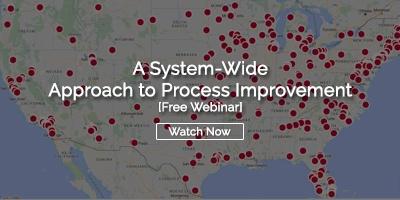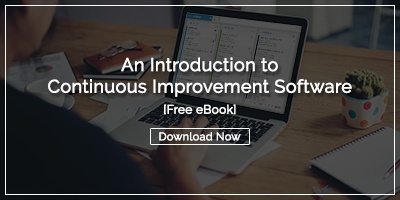
In today's fiercely competitive business landscape, success hinges on the relentless pursuit of improvement. Within this demanding landscape, the efficient management of business processes becomes paramount. That's where cutting-edge process management software comes into play.
Continuous and process improvement are twin pillars of organizational growth, underpinning the essence of business evolution.
This article will provide a detailed comparison that clarifies the distinctions between these two concepts.
The Roles of Continuous Improvement and Process Improvement in Business
Together, these concepts provide the sturdy foundation upon which modern businesses construct their path to sustainable success.
Impacts of Continuous Improvement on Business
Continuous improvement is a systematic and continuous process, involving an ongoing effort to incrementally enhance processes, products, or services in order to achieve higher efficiency and quality. Its distinguishing characteristic is its perpetual nature, where organizations seek small but consistent incremental improvements, fostering a culture of never-ending enhancement.
Two notable examples of organizations successfully applying continuous improvement process principles are Toyota and Amazon. Toyota's famous "Toyota Production System" is a sterling example of a culture of continual improvement on the factory floor. Employees are encouraged to identify and address even the smallest inefficiencies, leading to significant gains in efficiency and higher employee engagement, as their ideas and efforts are valued.
Importance of Process Improvement in Business
Process improvement is an episodic effort to enhance a specific aspect of a process, product, or service to achieve better efficiency or effectiveness within a defined timeframe. In contrast, continuous process improvement is an ongoing, systemic approach to making incremental improvement happen across all aspects of an organization without specific time constraints.
The methodologies commonly used in process improvement, such as Lean, Six Sigma, and Kaizen, share several core principles:
Customer Focus: These methodologies prioritize understanding and meeting customer needs and expectations, ensuring processes are designed and improved with the end-user in mind.
Data-Driven Decision Making: They rely on data and statistical analysis to identify issues, measure process performance, and make informed decisions for process enhancements.
Eliminating Waste: Lean emphasizes eliminating non-value-added activities and resources, while Six Sigma focuses on reducing defects and variations. Kaizen seeks to continuously eradicate all forms of waste.
Standardization: Standardized processes and procedures are encouraged to minimize variability and maintain consistency in operations.
One notable real-world scenario where continual improvement led to significant enhancements is GE Aviation. By implementing Lean methodologies and adopting concepts like Just-In-Time (JIT) manufacturing, they reduced lead times, minimized waste, and enhanced overall efficiency.
Key Differences Between Continuous Improvement and Process Improvement
Goal-oriented Approach vs Systematic Approach
Process improvement is a goal-oriented method focused on making specific, targeted enhancements to an organization's process, existing system, or aspect within a defined timeframe. It often involves setting clear objectives, such as reducing defects or a cycle time, and implementing changes to achieve those goals.
In contrast, continuous improvement is a systemic approach that doesn't have specific endpoint goals or timelines. Continuous improvement fosters an environment where everyone is encouraged to identify and address inefficiencies and make incremental improvements in all aspects of the organization, not just in isolated processes.
Long-term Focus vs Short-term Focus
Process-driven improvement involves short-term objectives addressing specific issues or inefficiencies within a particular process or workflow. Organizations undertaking process improvement projects set specific, measurable, achievable, and time-bound (SMART) goals to achieve tangible and immediate results.
On the other hand, continuous improvement is inherently focused on an organization's long-term sustainability and growth. While it may involve short-term initiatives, its primary aim is to cultivate an enduring culture of improvement that transcends immediate goals.
Small Changes over Time vs Large Overtime Changes
Continuous improvement leads to small, incremental changes, gradually accumulating into significant improvements. This approach encourages organizations to constantly seek and implement minor, manageable enhancements in their processes, products, or services.
In contrast, process improvement often involves extensive, one-time changes or overhauls to resolve specific issues or inefficiencies. Organizations undertaking process improvement initiatives may need to restructure processes, implement new technologies, or introduce significant workflow changes. These disruptive changes require careful planning and execution to ensure a smooth transition.
What is the difference between process reengineering and continuous improvement?
Process reengineering and continuous improvement are both methodologies used to enhance organizational processes, but they differ in their approach and scope.
Process reengineering involves radical and fundamental changes to existing processes. It often starts with a "clean slate" mindset, rethinking and improving processes from the ground up to achieve significant improvements in efficiency, cost reduction, or other critical metrics. Process reengineering is usually disruptive, involves substantial changes, and may require considerable resources and time.
Continuous improvement is a gradual, iterative approach that encourages employees to regularly identify and address issues, inefficiencies, or bottlenecks. Continuous improvement is less disruptive and typically involves less resource-intensive changes.
Benefits and Limitations:
Continuous Improvement Benefits
Cultural Transformation: Continuous improvement fosters a culture of innovation and engagement where employees at all levels are empowered to identify and implement small improvements in their daily work.
Adaptability and Responsiveness: Continuous improvement equips organizations with the agility to respond swiftly to changing market conditions, customer needs, and emerging trends.
Sustained Long-Term Growth: While process improvement often focuses on achieving short-term gains, continuous improvement emphasizes the long-term sustainability of an organization.
Continuous Improvement Limitations
Resource Intensity: Sustaining a continuous improvement culture demands ongoing time and resources. Regular training, data collection, and employee involvement require investments that may not yield immediate, quantifiable returns.
Resistance to Change: Continuous improvement can face resistance from employees who may find the constant need for adjustment and adaptation challenging. There may be pushback against frequent process changes or a perception that it disrupts established routines.
Risk of Complacency: In some cases, focusing on small, incremental changes may lead to complacency, where organizations overlook the need for more considerable, transformative improvements. Overreliance on incremental adjustments can hinder major breakthroughs.
Process Improvement Benefits
Significant Efficiency Gains: Process improvement initiatives often result in substantial efficiency gains, especially when reengineering or redesigning core processes.
Streamlined Processes: Process improvement typically aims to streamline and optimize existing workflows. Organizations can achieve efficient workflows and more streamlined operations by eliminating unnecessary steps, bottlenecks, and redundancies, improving resource utilization and overall effectiveness.
Overcoming Critical Issues: Process improvement is well-suited for addressing critical issues or problems within a process. When a process is fundamentally flawed or underperforming, process improvement can provide a structured approach to diagnose and rectify these issues, leading to more immediate and impactful results.
Process Improvement Limitations
Risk of Over-Engineering: In pursuit of process perfection, there is a risk of over-engineering. Organizations may invest excessive time and resources in refining processes that do not yield commensurate benefits.
Unintended Consequences: Changes made during process improvement can sometimes have unintended consequences elsewhere in the organization. These unintended consequences may only become apparent after implementation.
Lack of Alignment: Process improvement initiatives may not always align with broader organizational goals and strategies. Focusing on isolated process improvements without considering the larger picture can lead to suboptimal results.
Choosing the Right Approach for Your Organization:
Given that both continuous improvement and process improvement methods have significant benefits and potential speed bumps, it is essential to consider the right approach for your unique business. The good news is that you don't have to pick one or the other. Many organizations take a hybrid approach by adopting a continuous improvement culture and applying process improvement techniques when appropriate. This integrated strategy allows for a comprehensive approach to enhancing existing processes and driving business strategy.
Assessing Business Needs and Goals
Begin by assessing the needs and business goals of your organization. Are you facing any clear process breakdowns that need immediate attention? Are your existing systems and processes sufficient but inefficient or slow? Are there changes in your industry that require immediate or long-term transformation? What are your crucial strategic goals, and is there a clear path to achieving them through continuous improvements?
Answers to questions like these will help you decide where to apply improvement principles and in which order to address your business processes. This assessment serves as the foundation for making informed decisions about where and how to implement continuous improvements to achieve dramatic improvements in process performance.
Considering Resources and Constraints
After clearly defining your needs and goals, it's essential to be realistic about your resources and constraints. Assuming your resources are not unlimited, your business strategy should guide your prioritization of core business processes for improvement. The good news is that even with limited resources, you can achieve significant improvements through employee involvement, incremental change, and data-driven decision-making, all within the framework of your overall business strategy.
Measuring Progress and Success
Measuring the impact of continuous improvement is a multifaceted endeavor that extends beyond mere metrics. Employee engagement, morale, and a culture of innovation often indicate success. Ultimately, the accurate measure of organizational improvement lies in the ability to adapt, evolve, and thrive in an ever-changing landscape, where a commitment to ongoing enhancement becomes not just a metric but a fundamental part of its DNA.
Measuring the impact of process improvement involves a meticulous assessment of quantifiable outcomes and efficiency gains. Key performance indicators (KPIs) such as reduced cycle times, lowered costs, increased throughput, or enhanced product quality serve as critical benchmarks. These measures are essential to track the tangible benefits and overall success of your process improvement initiatives.
Conclusion
A hybrid approach that synergizes the strengths of continuous and process improvement methodologies involves fostering a culture of constant improvement as the overarching philosophy while strategically implementing process improvement initiatives as needed. This approach promotes ongoing, incremental enhancements as the norm, empowering employees to identify and address issues regularly. Simultaneously, process improvement projects are initiated for significant process inefficiencies or fundamental transformations, harnessing structured methodologies to deliver swift, substantial improvements. By seamlessly integrating both methods, organizations can balance constant evolution and targeted impactful changes, ensuring adaptability and sustainable growth.




Add a Comment